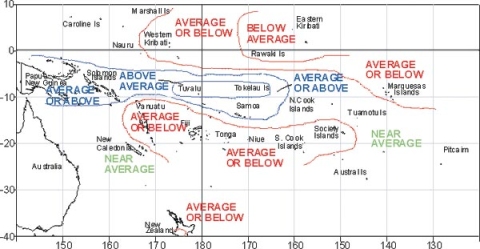Rainfall outlook for August to October 2003
Average or above average rainfall is expected from Papua New Guinea to Samoa Average or below average rainfall from Western Kiribati trending east-southeast to the Marquesas Islands
The SPCZ is expected to be near its normal position, with some enhancement about and west of the Date Line. Above average rainfall is expected from Tuvalu to Tokelau, while Papua New Guniea, the Solomon Islands, the Wallis and Futuna islands and Samoa are expected to experience average or above average rainfall. Rainfall is likely to be average or below average from Western Kiribati trending east-southeast to the Marquesas Islands, with below average totals in Eastern Kiribati. Another region of average or below average rainfall is expected from Vanuatu to the Society Islands, including Fiji, Tonga, Niue, the Southern Cook Islands and the Marquesas Islands. Near average rainfall is expected elsewhere in the region. The skill of most of the forecast models is moderate to low for this time of the year as the forecast crosses into a transition period from the dry to the wet season.
Rainfall outlook map for August to October 2003

Probabilities of rainfall departures from average
Broad-scale rainfall patterns and anomalies in the southern tropical Pacific area are estimated from the state of large-scale regional climate factors, such as La Niña or El Niño, their effect on the South Pacific and Tropical Convergence Zones, surface and subsurface sea temperatures, and computer models of the global climate.
Rainfall estimates for the next three months for Pacific Islands are given in the adjacent table. The tercile probabilities (e.g. 20:30:50) are derivedfrom the interpretation of several global climate models. They correspond to the odds of the observed rainfall being in the lowest (driest) one third of the rainfall distribution, the middle one third, or the highest (wettest) one third of the distribution. On the long-term average, rainfall is equally likely (33% chance) in any tercile.
The probabilities shown express the expected shift in the distribution from the long-term average, based on predictions of oceanic and atmospheric conditions. The amount of inter-model forecast consistency is indicated by the levels of confidence expressed in the table.
| Island Group | Rainfall Outlook | Confidence in the Outlook | |
|---|---|---|---|
| Tuvalu | 20:30:50 | (Above average) | Moderate |
| Tokelau | 20:20:60 | (Above average) | Moderate |
| Papua New Guinea | 20:35:45 | (Average or above average) | Moderate |
| Solomon Islands | 20:40:40 | (Average or above average) | Moderate |
| Wallis and Futuna | 15:45:40 | (Average or above average) | Moderate – Low |
| Samoa | 20:40:40 | (Average or above average) | Moderate – Low |
| New Caledonia | 30:40:30 | (Near average) | Moderate – Low |
| Northern Cook Islands | 25:50:25 | (Near average) | Moderate – Low |
| Austral Islands | 30:50:20 | (Near average) | Low |
| Tuamotu Islands | 20:60:20 | (Near average) | Moderate – Low |
| Pitcairn Island | 15:50:35 | (Near average) | Moderate – Low |
| Western Kiribati | 40:40:20 | (Average or below average) | Low |
| Vanuatu | 35:45:20 | (Average or below average) | Moderate – Low |
| Fiji | 40:40:20 | (Average or below average) | Moderate – Low |
| Tonga | 40:40:20 | (Average or below average) | Low |
| Niue | 40:40:20 | (Average or below average) | Low |
| Southern Cook Islands | 35:45:20 | (Average or below average) | Low |
| Society Islands | 25:45:20 | (Average or below average) | Low |
| Marquesas | 40:45:15 | (Average or below average) | Moderate – Low |
| Eastern Kiribati | 50:30:20 | (Below average) | Moderate – Low |
Rainfall outcomes as estimated from models and historical records. The third column indicates the probability of bottom (below), middle (average) or top (above) tercile rainfall, where a percentage is given. The rainfall outlook (second column) is subjectively estimated from the probabilities of bottom, middle and top terciles.
